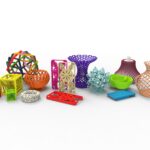I. Understanding Advanced CNC Upcycling Techniques
II. Benefits of Using Recycled Materials in CNC Projects
III. Innovative Complex Designs Achievable Through CNC Technology
When we talk about advanced CNC upcycling techniques, it’s like opening a treasure chest filled with creative possibilities! CNC, or Computer Numerical Control, is a fantastic tool for turning what would otherwise be waste materials into stunning, functional pieces. Let’s take a closer look at what these techniques are all about and how you can start using them in your own projects.
What is CNC Upcycling?
At its core, CNC upcycling is the process of taking discarded or surplus materials and transforming them into new, valuable products using CNC machinery. It’s not just about recycling; it’s about reimagining! You can give an old pallet new life as a piece of furniture or turn remnants from a construction project into eye-catching art. The key is in the creativity and the technology.
Advanced Techniques You Should Know
So, what makes upcycling with CNC advanced? Here are some techniques that can elevate your projects:
- 3D Scanning: This technique involves scanning an object to create a digital model. From there, you can modify and replicate it in a new form, allowing for intricate designs that capture the essence of the original item.
- Multi-Material Machining: By using multiple types of materials, you can create complex designs that mix metals, plastics, and wood. Imagine a lamp that has a wooden base and a metal shade, all crafted from recycled materials!
- Adaptive Tooling: This involves using specialized tools that can be adjusted for different materials. It allows you to work efficiently with various upcycled materials, ensuring a precise and polished finish.
- Layered Construction: Techniques like laminating or layering materials can add depth and texture to your projects. This is especially effective for creating unique shapes that might be impossible with traditional methods.
Getting Started
If you’re excited to dive into the world of CNC upcycling, here are some tips to get you started:
- Gather Materials: Start by collecting scrap materials from local businesses, home improvement stores, or even your own garage. Be on the lookout for wood, metal, or plastics that can be transformed.
- Learn Your Machine: Familiarize yourself with your CNC machine’s capabilities. Understanding how it works will help you make the most of its features and ensure you’re using it to its full potential.
- Plan Your Project: Sketch your ideas and create a digital design using CAD software. This planning stage is crucial to visualize the end product and make adjustments before you start machining.
- Start Small: If you’re new to CNC upcycling, begin with smaller projects. This will allow you to build confidence and skills without feeling overwhelmed.
Conclusion
Advanced CNC upcycling techniques open up a world of creativity and sustainability. By combining technology with imagination, you can turn discarded materials into something truly exceptional. So, grab your CNC machine, gather your materials, and let your creativity soar!
The Benefits of Using Recycled Materials in CNC Projects
Hey there, fellow maker! If you’re diving into the world of CNC (Computer Numerical Control) projects, let’s chat about something really exciting: using recycled materials. It’s more than just a trend; it’s a fantastic way to innovate while being eco-friendly! So, let’s break down some of the key benefits of incorporating recycled materials into your CNC endeavors.
1. Environmental Impact
First and foremost, using recycled materials helps reduce waste. Did you know that approximately 2.7 billion tons of waste are generated every year? By opting for recycled materials, you’re contributing to a smaller carbon footprint. It’s like a tiny superhero move for our planet!
2. Cost-Effective Solutions
Let’s be real: CNC projects can sometimes be pricey. By utilizing recycled materials, you can significantly cut down on costs. Many times, these materials can be sourced locally or even salvaged from old furniture or construction sites. This means more budget left over for designing that incredible piece you’ve been dreaming about!
3. Unique Aesthetics
One of the coolest aspects of using recycled materials is their unique character. Each piece has a story, and that can add an incredible depth to your projects. Whether it’s the weathered wood from an old barn or metal scraps from a factory, these materials lend authenticity and distinctiveness that new materials often lack. Think about it: your project can feature one-of-a-kind textures and colors that truly stand out!
4. Versatility in Design
When you incorporate recycled materials, you’re not just limited to traditional options. The beauty of CNC technology is that it can work with a variety of materials, from plastics to metals and wood. You can experiment with different textures and layouts, giving you a broad canvas to unleash your creativity!
5. Skill Development
Working with recycled materials can challenge your problem-solving skills in the best way possible. Every piece is different, which means you’ll need to think outside the box to make it work for your project. This hands-on experience is invaluable and enhances your craft. Plus, it’s super satisfying to see what you can create from what others might consider “waste.”
6. Community Engagement
Finally, embracing recycled materials can also foster a sense of community. Think about local workshops, maker spaces, or community groups focused on sustainability. You can share ideas, resources, and even materials! It’s a fantastic way to connect with like-minded individuals who are just as passionate about making and minimizing waste.
In conclusion, using recycled materials in your CNC projects isn’t just beneficial for the environment; it’s a brilliant way to save money, express creativity, and connect with your community. So next time you’re gearing up for a new project, consider hitting up your local thrift store or asking around for scrap materials. Trust me; you’ll be amazed at what you can create!
“`html
Innovative Complex Designs Achievable Through CNC Technology
Have you ever marveled at the intricate details of a sculpture or the sleek lines of a modern piece of furniture? With CNC technology (Computer Numerical Control), creating complex designs has never been easier or more accessible. Let’s dive into how CNC machines are revolutionizing the design landscape, enabling both hobbyists and professionals to bring their most imaginative ideas to life.
What Makes CNC Technology So Powerful?
At its core, CNC technology is all about precision. Unlike manual tools, CNC machines are controlled by computer programs that guide their movements with remarkable accuracy. Here are some of the defining characteristics of CNC technology that make it perfect for innovative design:
- Precision Cutting: CNC machines can cut materials to exact specifications, ensuring that every piece fits together perfectly.
- Complex Geometry: They can handle intricate shapes and designs that would be nearly impossible to create manually, such as curves and fine details.
- Repeatability: Once a design is programmed, it can be replicated numerous times without any loss in quality, making it ideal for mass production of unique items.
Exploring Design Possibilities
With CNC technology, the sky is the limit! Here are some innovative design possibilities you can explore:
- Furniture Design: Imagine a coffee table with a wave-like top or a bookcase that defies traditional geometry. CNC allows you to create striking furniture pieces that challenge conventional aesthetics.
- Art Installations: Artists can use CNC machinery to craft stunning sculptures or interactive installations that captivate audiences with their complexity and detail.
- Architectural Elements: From custom moldings to intricate facades, CNC technology can produce architectural details that enhance any building, adding a touch of modern elegance.
Combining Creativity with Technology
One of the most exciting aspects of CNC design is the combination of creativity and technology. By harnessing software like CAD (Computer-Aided Design), you can sketch, modify, and finalize designs before they even touch the material. This not only streamlines the design process but also allows for instantaneous revisions, so you can iterate your designs quickly.
Moreover, the ability to simulate how a design will look when finished can help you visualize the end product, making adjustments as necessary. It’s like having a digital canvas at your fingertips!
Tips for Getting Started with CNC Design
If you’re eager to jump into the world of CNC design, here are a few tips to get you started:
- Start Small: Begin with simpler projects to familiarize yourself with the software and machinery.
- Utilize Online Resources: There are countless tutorials and forums available that can guide you through the learning curve.
- Experiment: Don’t be afraid to try out different materials and designs. The beauty of CNC technology is its forgiving nature—most mistakes can be corrected!
In conclusion, CNC technology is a powerful tool that opens up a world of complex design possibilities. Whether you’re a seasoned professional or a curious beginner, exploring the potential of CNC can lead to some truly innovative creations. So, fire up those machines and unleash your creativity!
“`




Comments